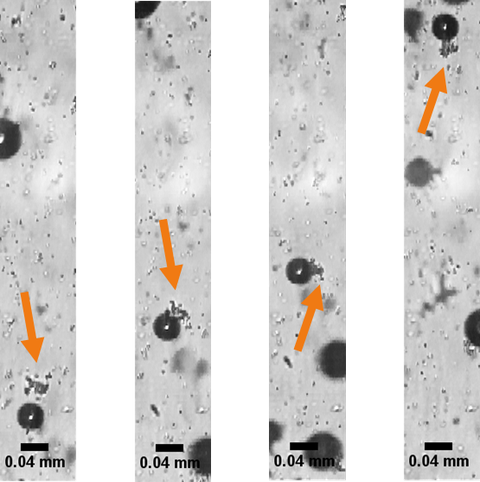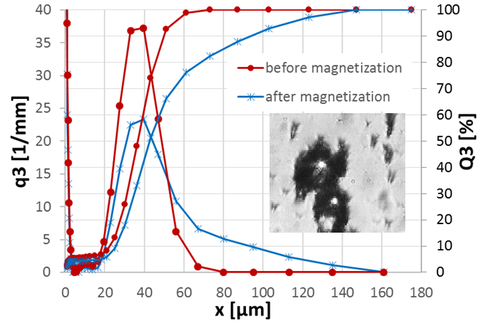Agglomeration and flotation
Concact person: Dr.-Ing. Karin Schwarzenberger
Motivation
During the multiple steps of ore processing or recycling, particles can reach the size of a few microns or smaller. Other kinds of particles, such as microalgae cells, naturally have this size range. Classical separation technologies like froth flotation reach their limits for this ultra-fine particle fraction. By inducing an attractive particle-particle interaction, an agglomeration process takes place so that the resulting larger particles can be separated.
Algae flotation

Attachment of algal agglomerate at microbubble surface
Algae biomass is a promising resource, e.g. for the production of biofuels. The energy-intensive dewatering of algae biomass from its culture medium remains one of the big challenges for an economical production process. Due to its scalability and easy construction, froth flotation shows considerable potential for a cost-efficient initial dewatering step. Chitosan as a bio-compatible collector was employed for the hydrophobization and agglomeration of microalgae cells. A striking correlation between the recovery and the isoelectric point of the algal suspension depending on the chitosan concentration could be shown. By tuning the agglomerate and bubble size, the hydrodynamic interaction was optimized for an efficient attachment of the algal cells to the rising bubbles.
Magnetic carrier flotation
Carrier flotation has the potential of separating very small particles by using hydrophobized magnetic microparticles instead of microbubbles. The preconditions in carrier flotation are an efficient mixing along with a high probability for collision and attachment of carrier and valuable particles. For a deeper understanding of these processes on the microscale, model experiments with fluorescent microspheres as valuable particles were carried out. A collection event, during which a cluster of magnetic nanoparticles is attached to a microsphere, typically consists of three steps:
- Approaching of both particles due to their relative velocity
- Contact of the particle surfaces with attractive particle-particle interaction
- Reorientation of the freshly formed aggregate in the flow field
By applying a magnetic field, large aggregates containing several clusters of magnetic nanoparticles and microspheres were formed. These strongly covered valuable particles could be directed to the desired location in the container and separated. After the magnetic field was removed, the large clusters disaggregated again so that most of the carrier particles could be recovered.
Publications
C. Matho, K. Schwarzenberger, K. Eckert, B. Keshavarzi, T. Walther, J. Steingroewer, F. Krujatz, Bio-compatible flotation of Chlorella vulgaris: Study of zeta potential and flotation efficiency. Algal Research, 44 (2019), 101705.
S. P. Schwaminger, K. Schwarzenberger, J. Gatzemeier, Z. Lei, K. Eckert, Magnetically Induced Aggregation of Iron Oxide Nanoparticles for Carrier Flotation Strategies. ACS Applied Materials & Interfaces, 13 (2021), 20830-20844.

